The picturesque little town (or rather municipality) of Aranjuez is perfect in every sense of the word. The train will get you there in about an hour, and driving takes forty-five minutes from Madrid. The view out of the train window is beautiful, with hundreds of hectares of green countryside stretching out as far as the eye can see with greenhouses and farms sweeping past.
Let's start with Aranjuez Station...
Aranjuez manages to be inspiring from the moment you step off the train, since the train station is very unusual. You won't find a station similar in design and architecture in the whole of Madrid (apart from Atocha). There are lots of clocks hanging from the ceilings, reminiscent of train stations from many years ago, and the roof and structure are designed in a style I had never heard of before: Neo-Mudéjar, a type of Moorish revival architecture.

Neo-Mudéjar-style roof of Aranjuez train station.
Neo-Mudéjar style originated on the Iberian Peninsula, and was a very popular style in Spain for many years. To give you an idea, Neo-Mudéjar style is more or less an Arabic style involving a lot of colour play and was used by many Nasrid royals. The ceilings of the Aranjuez station are very high and feature horseshoe arcs, and the platforms are open-air.

Clock at Aranjuez station, near the platform.
The history of Aranjuez
Initially, the Royal Palace of Aranjuez was built to fulfill Charles V the Handsome's desire for a large villa he could spend a short period of the year living in. Its style is very different to that of the Royal Palace of Madrid, which appears to be made of marble and is visually more attractive. This palace, however, has Italian inspiration. The design of the palace seems so constant that you would never believe it had two architects: the first, Juan Bautista de Toledo, died while the palace was still under construction. The palace is made of white stone and brick, explaining its reddish hue. In my opinion, the Palace of Aranjuez doesn't seem to be as well-maintained as the Royal Palace of Madrid, something which is noticeable from the upper decoration and from the windows.
The Bourbons are said to have spent springtime here in the Royal Palace of Aranjuez, arriving at Easter and staying until July (I'll explain the reasons why they never stayed very long later on). The palace was expanded and perfected over many years, since every new king wished to add something new and different. It could be said that the palace was not entirely finished and 'completely splendid' until 1879, at least in the eyes of the kings.
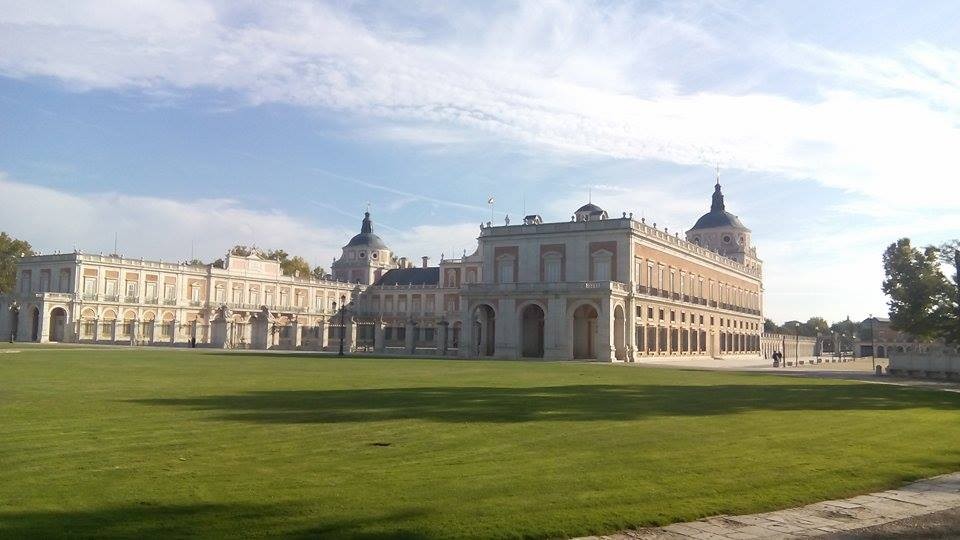
View of the Royal Palace from the main path. Access to the building is around the side. Can you see the fruits of the garden maintenance? It really looks like a fantastic place to spend springtime in this photo!
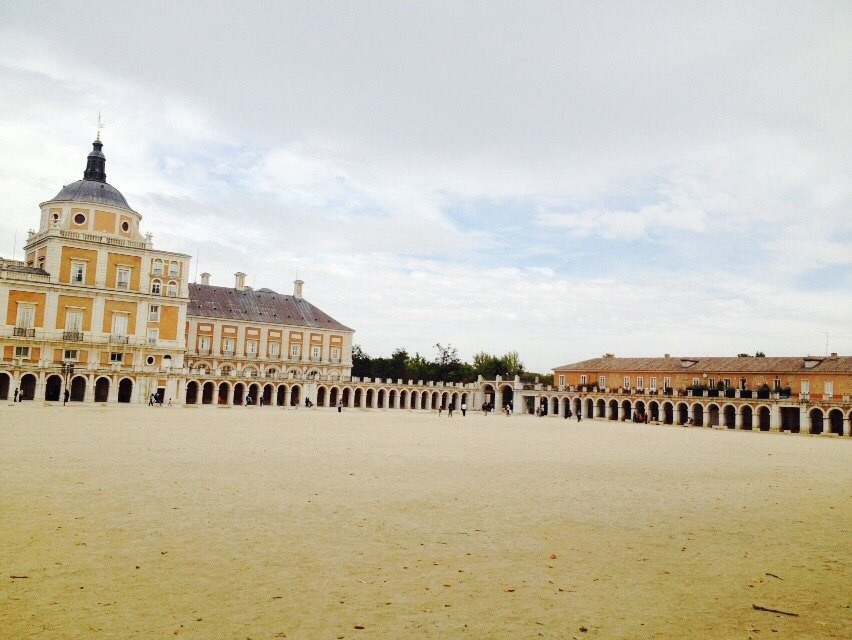
View of the palace from a central square, with filter.

I love this photo of the arches which surround the palace's entrance, they look endless! The musicians can also be found around here!

One of the side and back gardens of the palace. This garden is very small and is not publicly accessible.
This place isn't talked about very much. If you go to Madrid, nobody will say to you 'Oh! You have to go to the Aranjuez Palace! ', since in comparison with other monuments, it's not high up on the priority list. If you're in Madrid as an exchange student for a semester or longer though, I really recommend you visit the palace, above all because by going there you'll see how the city can change if you travel just a few kilometres outside of it.
You cannot miss this striking corner of Madrid. Joaquín Rodrigo's musical composition 'Aranjuez Concierto' was dedicated to the Palace of Aranjuez, and it was declared a UNESCO World Heritage site in 2001.
Inside a 'small' royal palace, large rooms are found
Sadly I couldn't take any photos inside the palace, since, for one, it's not allowed, and the employees watch you very closely to make sure that you don't take any. I'll try and show you some that I did manage to take, although I'd have liked them to be of better quality.
Among the objects considered to be works of art are some clocks, sculptures, paintings, impressively decorated furniture, musical instruments (such as the piano the queen played, made of ancient wood), textiles and upholstery (which adorn each and every room) and even armoury.
The most important rooms
There are lots of beautiful halls and rooms, and you're able to explore them all since despite its size, the rooms of the Palace of Aranjuez can be covered on foot in an hour. We were lucky enough to visit at the same time as a guided tour was going on, and kept 'bumping into' them for almost the entirety of the tour (we deliberately left a bit of time before we moved rooms, haha). There are however a few extra rooms you can only visit if you on the guided tour, but we were able to listen to interesting facts while the tour was going on.
The first thing you'll see when you enter is the grand staircase (and it's from this point onwards that photography is not allowed). The first room is the guards' room, which features many paintings by Lucas Giordano (not forgetting that the palace has Italian inspiration), lots of olivewood furniture and French vases. Next comes the queen's small room and the queen's antechamber (with marble floors, they spared no costs here! ). The queen also had a music room with a beautiful tapestry on the wall and a piano from 1849.
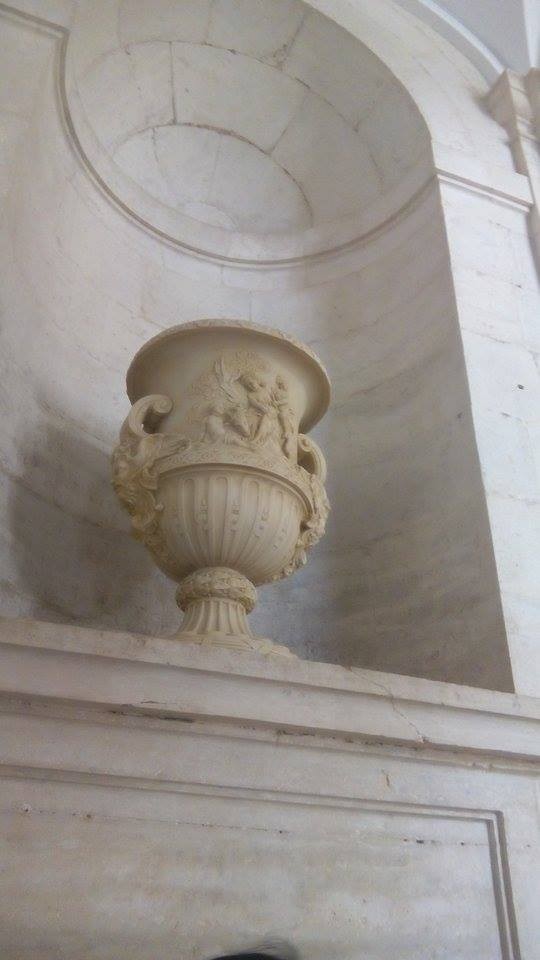
The first and only photo I managed to take before they told me off...
The palace rooms include an ante-chapel (look out for the stone panels which were a present from royal weddings), Charles IV's ante-chapel, the Isabelina room, the childrens' room, the throne room (where Charles IV dined, and where you can see his collection of French clocks), the queen's study, the queen's bedroom, the queen's dressing room, the ballroom, the living room, the king's room (kings and queens usually slept in separate rooms), King Francisco's bedroom, the mirror room, King Francisco's study, Maria Luisa's ante-chapel, the king's guard room, and the royal chapel.
One of my favourites: the porcelain room
This magnificent work of art was commissioned by Phillip V, and has marble flooring. As its name suggests, porcelain can be found everywhere in this room, on the walls as well as the floor. Reliefs and mirrors decorate the walls, which is the reason why the room is also known as the mirror room.
The walls are covered with reliefs of polychrome and golden garlands. A Chinese influence can be seen through the presence of birds, monkeys and changuitos. This was one of the rooms that left me astonished.
The visually impressive Arabic sitting room
This room was the most visually attractive of all the rooms in the palace, and was used by the king as a smoking room. Although it was built between 1848 and 1850, it already had a small fan installed (according to the technology of the time). It's said that this room was a gift from Queen María Cristina to King Francisco de Asís. The room has a very Arabic feel to it, and is in fact based on the Room of the Two Sisters in the Alhambra palace in Granada. The rooms were designed by the same architect, Francisco Contreras.
The 'modern-day' royal family
After passing through the rooms listed above, there is one last room located in the side wings of the palace. In this room, the best-known outfits of the current monarchs are on show, including the wedding dress and crown worn by Letizia at her wedding to Felipe in Almudena Cathedral in 2004.
In case you want a souvenir...
There is a shop in the palace where you can buy postcards, key rings, bags, and even childrens' toys (which have nothing to do with the palace! ). There are guidebooks on Madrid, Spain and Aranjuez in various languages, in addition to souvenirs from the recent coronation of King Phillip and Queen Letizia.
The most beautiful gardens you'll ever see!
The gardens of the Royal Palace of Aranjuez are one of the main tourist attractions as they are so well-maintained. Unfortunately, we weren't able to see one of the most important areas since it was closed due to damage from heavy rain.
On a stroll through the gardens, visitors will come across the River Tajo, which flows through the land using many different canals. It's pleasant to walk through the gardens and sit down on the river's banks to admire the sculptures, flower arrangements, music (there is always peaceful music playing, usually an accordion) and even a large enclosure full of beautiful birds.
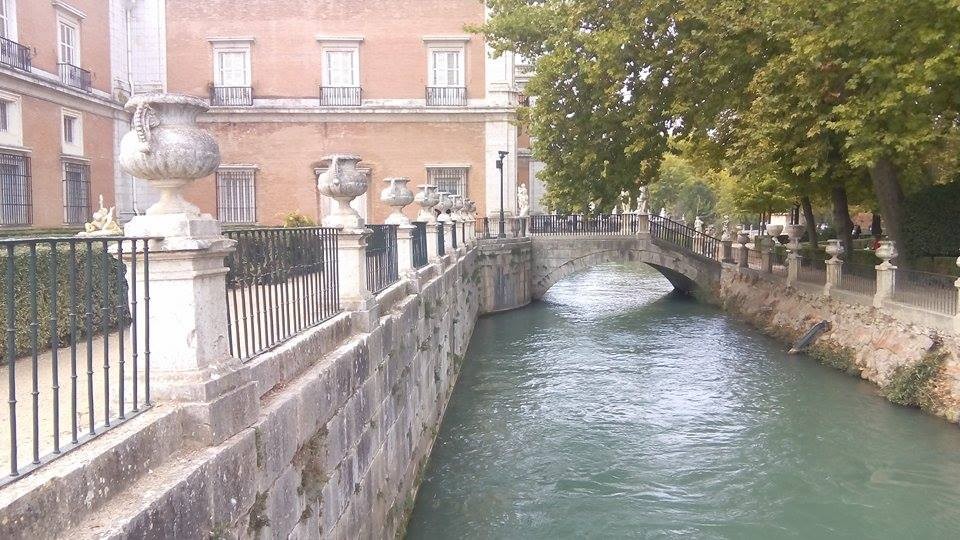
The side of the Royal Palace of Aranjuez with the Rio Tajo flowing next to it
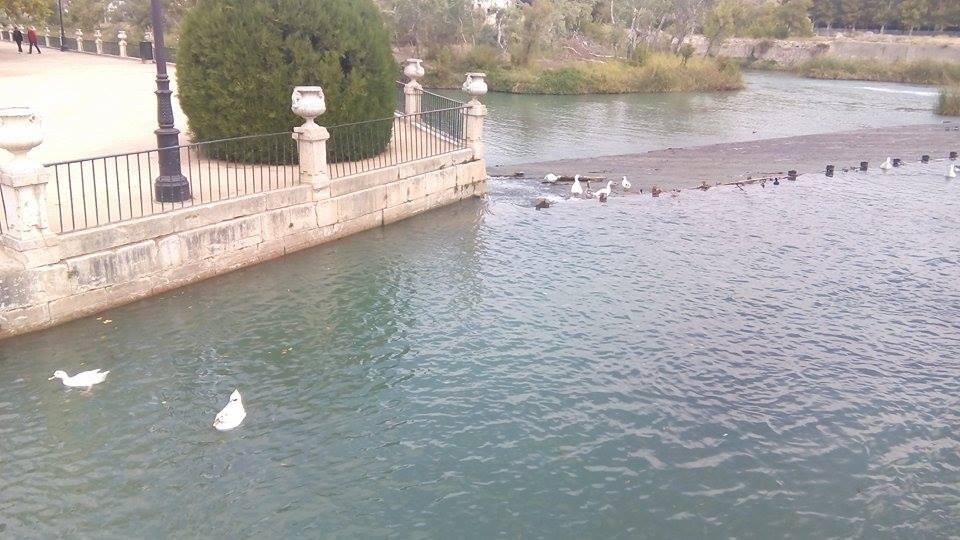
Another beautiful view of the Rio Tajo. Can you see the geese?
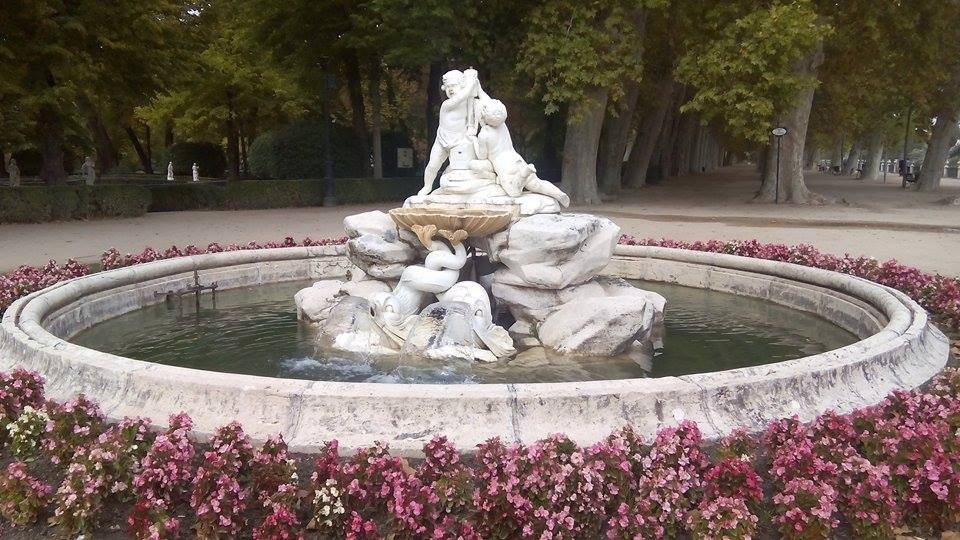
Another example of the seemingly unending fountains that you find here!
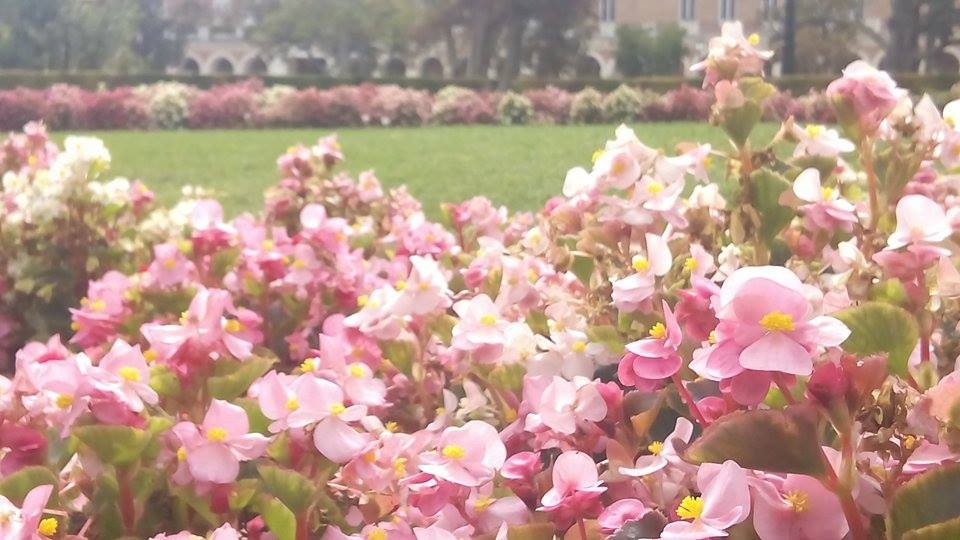
Here you can appreciate the detail and meticulous maintenance of the gardens.

Everyone needs a souvenir photo!
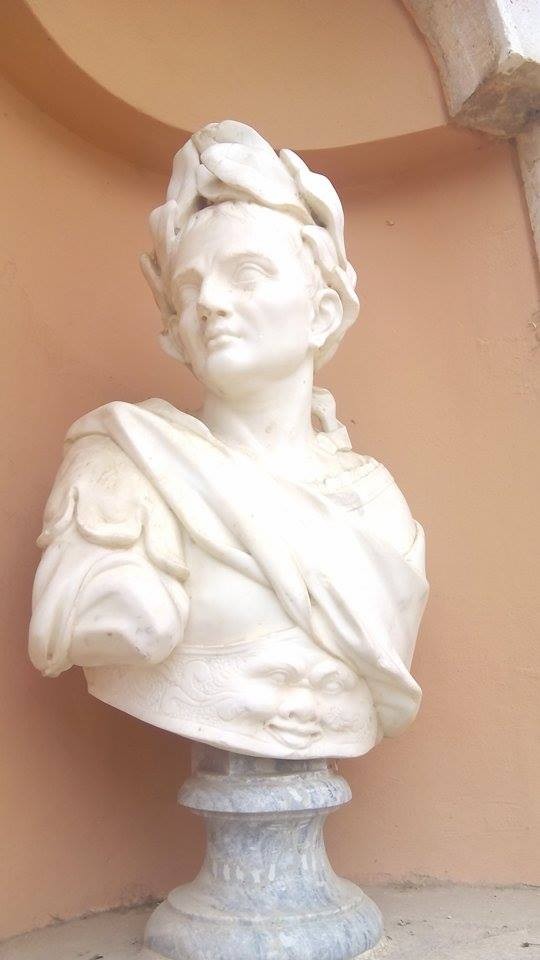
This statue can be found in the gardens! Have you noticed it's got two faces? Can you see the second one which is half-hidden?
How long my visit to Aranjuez took
Between leaving my house in Madrid and returning, five hours had easily gone by.
How much does it cost?
The normal entrance fee is 9 euros, but if you're a student and show your Madrid student card, your ISIC international student card or your card from your home university, you only have to pay 4 euros! The benefits of being a student...
If you want to join a guided tour or rent an audioguide, it only costs 4 euros!
The Island and Price Gardens are free to enter, and are well worth visiting.
Cost of transport: If you're under 26, be aware that from October onwards student public transport tickets are being reduced from 40 euros to 20 euros and now cover all zones in Madrid.
How to get there
The address of the Royal Palace is Avenida de Palacio, 28300 Aranjuez, Madrid.
The easiest way to get there is to use the bus or the train. If you arrive by train, you can walk to the palace from the station in ten minutes or less.
Opening hours
The gardens are normally open every day, from about 8am to 6. 30pm or even 8. 30pm - it depends on the garden, since there are so many of them. Bear in mind that in Spain, opening hours are very dependent on the time of year. The opening hours of museums or expositions are usually longer in the summer months.
The Royal Palace of Aranjuez is open from Tuesday to Sunday from 10am to 6pm (last admission 5pm) during the winter months.
During the summer months, the Palace itself is open from 10am to 8pm (last admission 7pm). As you've probably realised, the Palace isn't open on Mondays! Be careful not to plan your visit then, since as a student you'll probably have long weekends and be tempted to go visiting places on Mondays.
The last time we visited, we were unable to see some of the most beautiful gardens because they had been damaged by a storm. If you are visiting in order to see a specific garden, I recommend you check the website before your visit in case it's currently not open to the public.
Top tips
- It's best if you arrive at about 10am, since it gets busier later on (though don't worry, it's never too crowded with people to enjoy the view! )
- Souvenirs and postcards are much cheaper if you buy them outside of the Palace. If you visit the Palace with friends and you all want to buy postcards, I recommend you buy a packet of 12 for 3 euros, which is much better value than buying individual ones for 40 cents each. The only disadvantage to this is that you then can't choose your postcards.
- Lose yourself in the very well cared for gardens. Aranjuez has a very calm atmosphere, and you can understand why they chose this place to build a palace, even if just to live in for a few months of the year.

Don't forget to take a photo in front of the Palace! I hope you enjoy your visit as much as I did!
